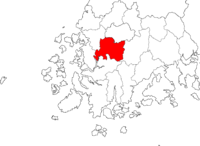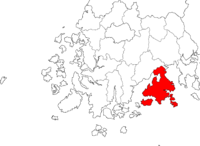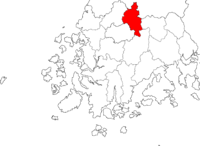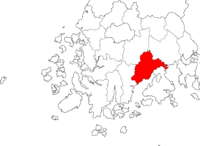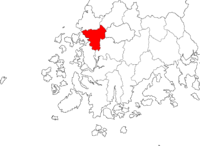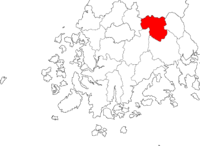South Jeolla Province (Korean: 전라남도; Hanja: 全羅南道; Jeollanam-do), also known as Jeonnam (Korean: 전남; Hanja: 全南), is a province in the Honam region, South Korea, and the southernmost province in mainland Korea. South Jeolla borders the provinces of North Jeolla to the north, South Gyeongsang to the northeast, and Jeju to the southwest in the Korea Strait.
South Jeolla Province 전라남도 | |
|---|---|
| Korean transcription(s) | |
| • Hangul | 전라남도 |
| • Hanja | 全羅南道 |
| • McCune‑Reischauer | Chŏllanam-do |
| • Revised Romanization | Jeollanam-do |
 | |
| Coordinates: 34°45′N 127°0′E / 34.750°N 127.000°E | |
| Country | South Korea |
| Region | Honam |
| Largest city | Suncheon |
| Capital | Muan County |
| Subdivisions | 5 cities; 17 counties |
| Government | |
| • Governor | Kim Yung-rok (D) |
| Area | |
| • Total | 12,335.13 km2 (4,762.62 sq mi) |
| • Rank | 3rd |
| Population (October, 2014) | |
| • Total | 1,817,697 |
| • Rank | 6th |
| • Density | 147.36/km2 (381.7/sq mi) |
| Provincial symbols | |
| • Flower | Camellia japonica |
| • Tree | Ginkgo |
| • Bird | Oriental turtle dove |
| GDP | |
| • Total | KR₩ 91 trillion US$ 73 billion (2022) |
| ISO 3166 code | KR-46 |
| Dialect | Jeolla |
| Website | Official website (English) |
Suncheon is the largest city in the province, closely followed by Yeosu. Other major cities include Mokpo, Gwangyang and Naju.
History
South Cholla was established in 1896 from the province of Cholla, one of the Eight Provinces of Korea, consisting of the southern half of its mainland territory and most outlying islands.
During the Japanese occupation of Korea from 1910 to 1945, South Cholla was known as South Zenra, with its provincial capital at Kōshū (now Gwangju). In addition, Cheju Island (now Jeju Island) was part of South Cholla until August 1, 1946.
Kwangju (now Gwangju) was part of South Cholla until 1986 (when it became a Metropolitan City) and the capital until 2005, when the provincial government relocated from Gwangju to Muan County to the planned town of Namak.
Geography
The province is part of the Honam region, and is bounded on the west by the Yellow Sea, on the north by Jeollabuk-do Province, on the south by Jeju Strait, and on the east by Gyeongsangnam-do.
There are almost 2,000 islands along the coastline, about three quarters of which are uninhabited. The coastline is about 6,100 kilometres (3,800 mi) long. Some of the marine products, in particular oyster and seaweed cultivation, are leading in South Korea.
The province is only partially mountainous. The plains along the rivers Seomjin, Yeongsan and Tamjin are suitable for large-scale grain agriculture. There is abundant rainfall in the area, which helps agriculture. The province is also home to the warmest weather on the peninsula. This helps to produce large amounts of agricultural produce, mainly rice, wheat, barley, pulses and potatoes. Vegetables, cotton and fruits are also grown in the province.
A small amount of gold and coal is mined in the province, but industries have also been developed in the area.
Demographics
| Year | Pop. | ±% p.a. |
|---|---|---|
| 1980 | 2,923,191 | — |
| 1990 | 2,507,439 | −1.52% |
| 2000 | 1,996,456 | −2.25% |
| 2010 | 1,741,499 | −1.36% |
| 2015 | 1,799,044 | +0.65% |
| 2020 | 1,788,807 | −0.11% |
| Source: Citypopulation[2] | ||
Administrative divisions
Jeollanam-do is divided into 5 cities (si) and 17 counties (gun). Listed below is the name of each entity in English, hangul, and hanja.

| Map | Name | Hangul | Hanja | Population (2021)[3] | Area (km2) | Population density 2021 (per km2) | Subdivisions |
|---|---|---|---|---|---|---|---|
| Yeosu | 여수시 | 麗水市 | 268,687 | 510.08 km2 | 526.75/km2 | 1 eup, 6 myeon, 20 haengjeong-dong | |
| Mokpo | 목포시 | 木浦市 | 221,178 | 51.58 km2 | 4,288.06/km2 | 23 haengjeong-dong | |
| Suncheon | 순천시 | 順天市 | 273,827 | 907.43 km2 | 301.76/km2 | 1 eup, 10 myeon, 13 haengjeong-dong | |
| Gwangyang | 광양시 | 光陽市 | 144,226 | 458.89 km2 | 314.29/km2 | 1 eup, 6 myeon, 5 haengjeong-dong | |
| Naju | 나주시 | 羅州市 | 115,138 | 608.45 km2 | 189.23/km2 | 1 eup, 12 myeon, 7 haengjeong-dong | |
| Muan County | 무안군 | 務安郡 | 90,094 | 448.95 km2 | 200.68/km2 | 3 eup, 6 myeon | |
| Haenam County | 해남군 | 海南郡 | 63,242 | 1,013.8 km2 | 62.38/km2 | 1 eup, 13 myeon | |
| Goheung County | 고흥군 | 高興郡 | 58,873 | 807.23 km2 | 72.93/km2 | 2 eup, 14 myeon | |
| Hwasun County | 화순군 | 和順郡 | 60,136 | 786.9 km2 | 76.42/km2 | 1 eup, 12 myeon | |
| Yeongam County | 영암군 | 靈巖郡 | 55,998 | 604.24 km2 | 92.68/km2 | 2 eup, 9 myeon | |
| Yeonggwang County | 영광군 | 靈光郡 | 48,981 | 473.69 km2 | 103.40/km2 | 3 eup, 8 myeon | |
| Wando County | 완도군 | 莞島郡 | 47,210 | 396.13 km2 | 119.18/km2 | 3 eup, 9 myeon | |
| Damyang County | 담양군 | 潭陽郡 | 44,034 | 455.12 km2 | 96.75/km2 | 1 eup, 11 myeon | |
| Boseong County | 보성군 | 寶城郡 | 36,981 | 663.35 km2 | 55.75/km2 | 2 eup, 10 myeon | |
| Jangseong County | 장성군 | 長城郡 | 40,604 | 518.65 km2 | 78.29/km2 | 1 eup, 10 myeon | |
| Jangheung County | 장흥군 | 長興郡 | 34,268 | 618.2 km2 | 55.43/km2 | 3 eup, 7 myeon | |
| Gangjin County | 강진군 | 康津郡 | 31,941 | 500.28 km2 | 63.85/km2 | 1 eup, 10 myeon | |
| Sinan County | 신안군 | 新安郡 | 34,000 | 663.59 km2 | 51.24/km2 | 2 eup, 12 myeon | |
| Hampyeong County | 함평군 | 咸平郡 | 29,369 | 392.43 km2 | 74.84/km2 | 1 eup, 8 myeon | |
| Jindo County | 진도군 | 珍島郡 | 29,013 | 440.1 km2 | 65.92/km2 | 1 eup, 6 myeon | |
| Gokseong County | 곡성군 | 谷城郡 | 26,781 | 547.44 km2 | 48.92/km2 | 1 eup, 10 myeon | |
| Gurye County | 구례군 | 求禮郡 | 23,543 | 443.2 km2 | 53.12/km2 | 1 eup, 7 myeon |
Sister cities and provinces
 State of Arizona, United States
State of Arizona, United States State of Maryland, United States
State of Maryland, United States Gyeongsan, South Korea
Gyeongsan, South Korea Ipswich, Queensland, Australia
Ipswich, Queensland, Australia Bà Rịa–Vũng Tàu province, Vietnam
Bà Rịa–Vũng Tàu province, Vietnam State of Oregon, United States[4]
State of Oregon, United States[4] Sichuan Province, China
Sichuan Province, China Alcochete, Portugal[5]
Alcochete, Portugal[5]
Religion
Religion in South Jeolla (2005)[6]
According to the census of 2005, of the people of South Jeolla 30.5% follow Christianity (21.8% Protestantism and 8.7% Catholicism) and 16.1% follow Buddhism.[6] 53.4% of the population is mostly not religious or follow Muism and other indigenous religions.
Education
National universities with graduate schools
- Chonnam National University - Yeosu Campus
- Mokpo National Maritime University – Mokpo
- Mokpo National University - Mokpo/Muan County/Yeongam County
- Sunchon National University – Suncheon
Private universities with graduate schools
- Dongshin University – Naju
- Gwangju Catholic University – Naju
- Mokpo Catholic University – Mokpo
- Sehan University - Yeongam County Campus
- Youngsan Won Buddhist University – Yeonggwang County
- Chodang University – Muan County
- Hanlyo University – Gwangyang
Public institutes of higher education
- Jeonnam Provincial College – Damyang County/Jangheung County
Private institutes of higher education
- Chunnam Techno University – Gokseong County
- Dong-A College – Yeongam County
- Hanyeong College – Yeosu
- Koguryeo College - Naju
- Kwangyang Health College – Gwangyang
- Mokpo Science University – Mokpo
- Suncheon First College – Suncheon
- Suncheon Cheongam College – Suncheon
List of governors of South Jeolla Province
- 31st: Heo Kyung-man (July 1, 1995 – July 1, 1998) – 1st term
- 32nd: Heo Kyung-man (July 1, 1998 – July 1, 2002) – 2nd term
- 33rd: Park Tae-young (July 1, 2002 – April 29, 2004) – 1st term
- 34th: Park Jun-young (June 6, 2004 – July 1, 2006) – 1st term
- 35th: Park Jun-young (July 1, 2006 – July 1, 2010) – 2nd term
- 36th: Park Jun-young (July 1, 2010 – July 1, 2014) – 3rd term
- 37th: Lee Nak-yeon (July 1, 2014 – May 12, 2018)
- 38th: Kim Yung-rok (July 1, 2018 – )
Tourism

- Yeosu – Jinnamgwan Hall, Hyangiram, Yi Sun Shin Square
- Suncheon – Songgwangsa Temple, Seonamsa Temple, Nagan Eupseong Folk Village
- Mokpo – Mokpo Modern History Museum, Gatbawi Rock, Yudal Mountain
- Haenam – Ttanggut (End of the Land) Village, Mihwangsa Temple
- Gurye – Hwaeomsa Temple
- Damyang – Damyang Juknokwon, Metasequoia-lined Road, Soswaewon Garden
- Boseong – Boseong Green Tea Field Daehan Dawon
- Dochodo – Seonggaksa
References
Sources
- "KOSIS". kosis.kr.
External links

 South Jeolla travel guide from Wikivoyage
South Jeolla travel guide from Wikivoyage- Official website (in English)






